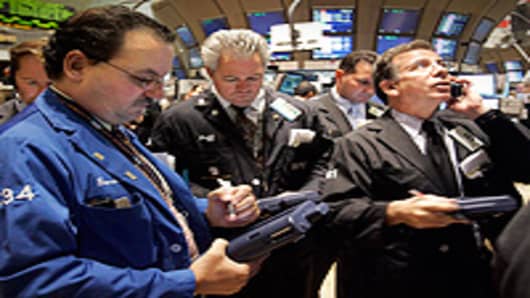Economic growth is precarious, unemployment is painfully high, debt levels are staggering and the stock market isn’t all that cheap.
That’s the view of Jeremy Grantham, the chief investment strategist at GMO, the Boston investment firm, who believes that the stock market is bound to endure some very lean years. But in the near term, there is a good chance that the market will rally, he said.
Why? “We are entering the sweet spot of the presidential election cycle. It’s very hard to bet against it.”
The presidential election cycle? Well, yes. A cottage industry has sifted the data going back more than a century and found that the stock market has generally done much better in the second half of a president’s four-year term than in the first. If history is a reliable guide — a big “if” — the market outlook should be brightening.
Since 1942, for example, the 200 days after a midterm election have produced “a remarkably consistent uptrend,” regardless of who wins, said Eric C. Bjorgen, a senior research analyst at the Leuthold Group. In a recent report, he found that in all 17 instances, the Standard & Poor’s 500-stock index had gains averaging more than 18 percent.
Are these numbers just a fluke? Quite possibly. There isn’t much hard evidence, and the history of presidential elections is too short for the patterns to pass a rigorous statistical test. Still, some people who have examined the cycle surmise that it reflects the simple desire of politicians to get themselves or their parties re-elected.
“I think a president is elected and tries to get rid of the dirty stuff in the economy as quickly as possible, so that by the time the next election comes around, he looks like a hero,” said Yale Hirsch, the former editor of The Stock Trader’s Almanac. He started analyzing the presidential election cycle in the almanac’s first edition in 1968. “The stock market is reacting to what the politicians are doing,” he said.
If the causes of the pattern aren’t clear, the numbers themselves are startling. “There is a strong historical tendency for the market to trend higher over the course of the third year of the presidential cycle,” said Tim Hayes, chief investment strategist at Ned Davis Research, an investment consulting firm.
Here are the average annualized returns for the Dow Jones industrial average from 1900 to 2009, as calculated by Ned Davis Research for the different years of a presidential term: 5.5 percent for Year 1; 3.7 percent for Year 2 (which would be this year); 12.6 percent for Year 3 (which would be next year); and 7.5 percent for Year 4.
The pattern is strong enough to count as “remarkable,” Mr. Hayes said, a word echoed by many strategists
“The pattern is quite remarkable,” said Liz Ann Sonders, chief investment strategist at Charles Schwab.
“These numbers are remarkable,” Mr. Grantham said.
“I love those numbers,” said Linda A. Duessel, equity market strategist at Federated Investors, who said that knowledge of the cycle had bolstered her cautiously bullish views of the market.
A husband-and-wife team, James R. Booth, now a professor of finance at DePaul University, and Lena Chua Booth, a professor at the Thunderbird School of Global Management, were unable to explain the pattern in a 2003 paper in The Review of Financial Economics. They tried to map the cyclical stock market returns to a deeper “political business cycle,” but didn’t find significant correlations to factors like inflation or interest rates.
“We were unable to come up with an explanation,” Mr. Booth said.
Kevin Grier, an economics professor at the University of Oklahoma, hasn’t studied the market cycle, but in a 2008 paper in Public Choice, he found evidence of a political business cycle corresponding closely to the election calendar. From 1961 to 2004, the money supply tended to start rising in the second year of a presidential term, followed by a rise in G.D.P., he concluded.
In a telephone interview, he said that he was only conjecturing, but that he believed that political influence on the Federal Reserve was responsible for the rise. “I think the idea that the Fed is divorced from politics and from real world affairs and conducts matters from an ivory tower setting is more of a myth than a reality,” he said. But with one exception, he said, “there is no smoking gun.”
That exception was in the Nixon administration. In 2006, with the aid of the Nixon White House tapes, Burton A. Abrams, an economics professor at the University of Delaware, found that in 1971 and early in the 1972 election year, Nixon pressured Arthur F. Burns, then the Fed chairman, to expand the money supply with the aim of reducing unemployment, expanding G.D.P. and ensuring Nixon’s re-election. Nixon also imposed wage and price controls to constrain inflation. He won in a landslide — only to resign in disgrace in the wake of the Watergate scandal.
But Nixon’s excesses may not have much bearing on the behavior of other presidents.
Even if presidents want to influence events, “it’s very difficult to change the course of the economy,” Mr. Grantham said. But, he added, it’s very easy to influence the markets, which are sensitive to signals from Washington. He says he is sure that many money managers will make bets based on the current cycle, but he advised individual investors to anchor their decisions on economic fundamentals.
As for Ms. Sonders, she said the election cycle didn’t supply enough information for formulating an investment strategy, adding that knowledge of it was “an important arrow to have in your quiver.”
For his part, Laszlo Birinyi, president of Birinyi Associates in Westport, Conn., who has studied the cycle extensively, said he did not rely on it to set strategy. “It’s interesting to note it,” he said. “But I don’t really pay much attention to it. I pick individual stocks. In a market like this, that’s the way to make money."


